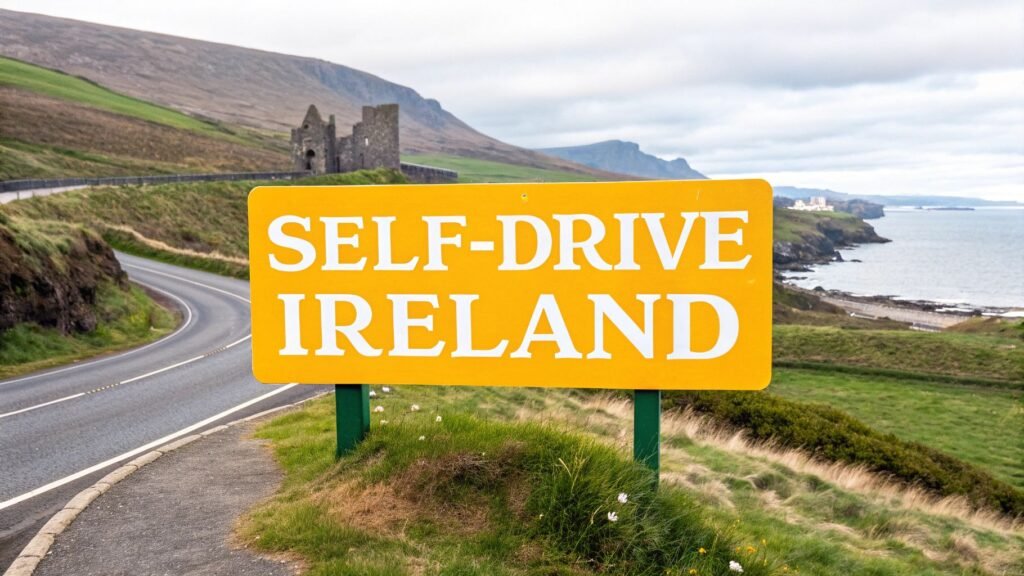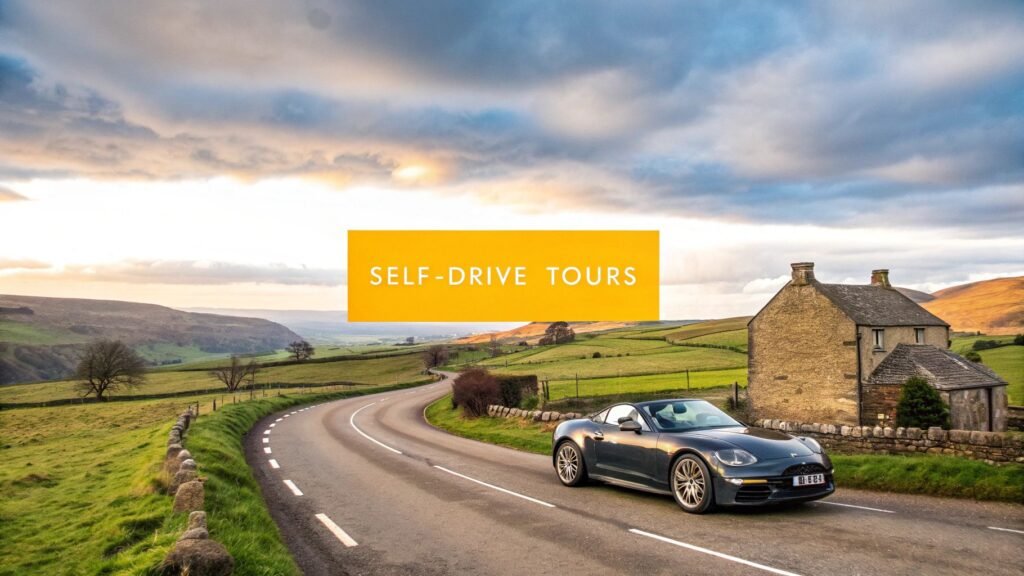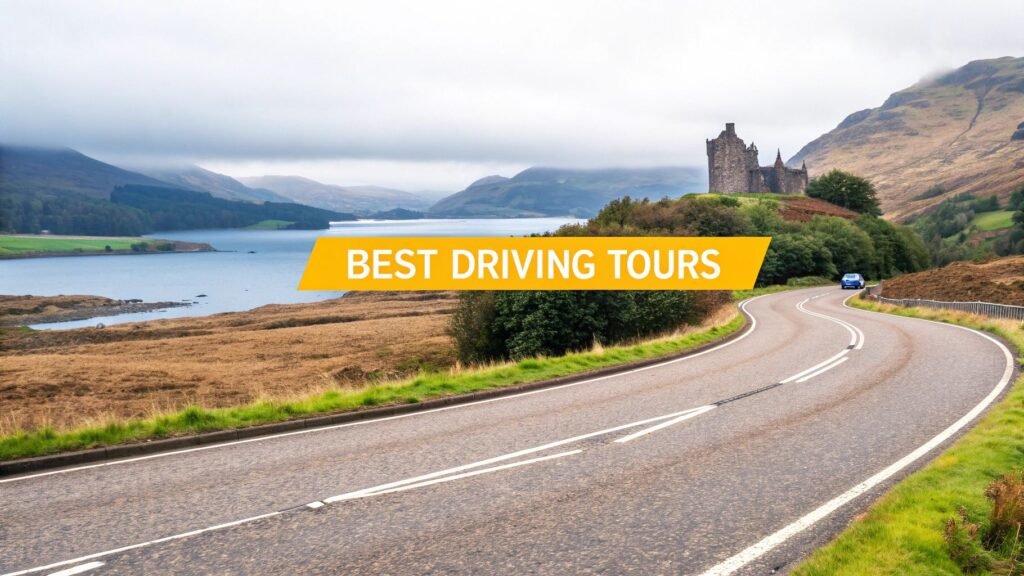Picture this: instead of following a strict bus schedule, you have the freedom to chase a rainbow down a winding country lane whenever the mood strikes. That’s the real magic of a self-guided tour of Ireland. It’s about seeing the Emerald Isle on your own terms and crafting a journey that feels truly, deeply yours.
Why a Self-Guided Tour Is the Best Way to See Ireland
Choosing how you’ll explore Ireland is the first big decision you’ll make, and honestly, it sets the tone for your whole trip. Guided coach tours are convenient, sure, but they tend to stick to a well-worn path, hustling from one major tourist spot to the next on a tight schedule. You’re part of a large group, which leaves little room for those spontaneous moments that make a trip unforgettable.
A self-guided tour, on the other hand, puts the map and the keys right in your hands. It’s the difference between being a passenger and becoming an explorer. This travel style is all about freedom and personalization, letting you linger a bit longer at a breathtaking cliffside or take an unplanned detour to a village that just looks too charming to pass by.
Embrace Flexibility and Authenticity
The biggest advantage of a self-guided trip is the ability to move at your own pace. You decide when the day starts, where you’ll stop for lunch, and exactly how long you want to soak in the atmosphere at each spot. This opens the door to far more authentic experiences that you’d likely miss on a big tour.
- Discover Hidden Gems: You’ll have the freedom to venture beyond the main tourist trail. Find those secluded beaches, stumble upon ancient ruins not in every guidebook, and settle into cosy pubs where you might just be the only visitor.
- Support Local Economies: When you choose your own B&Bs, cafes, and shops, you’re putting your money directly into the hands of small, family-run businesses that are the heart and soul of Irish communities.
- Create Your Own Schedule: Feel like spending an entire afternoon hiking in Killarney National Park? Want to dedicate a full day to getting lost on the Dingle Peninsula? A self-guided plan makes it happen.
The greatest joy of a self-drive trip is the unplanned discovery. It’s the conversations with locals, the impromptu stops for photos, and the freedom to let the day unfold naturally, creating memories that are uniquely yours.
This infographic breaks down some of the practical differences you’ll find when comparing the two travel styles.
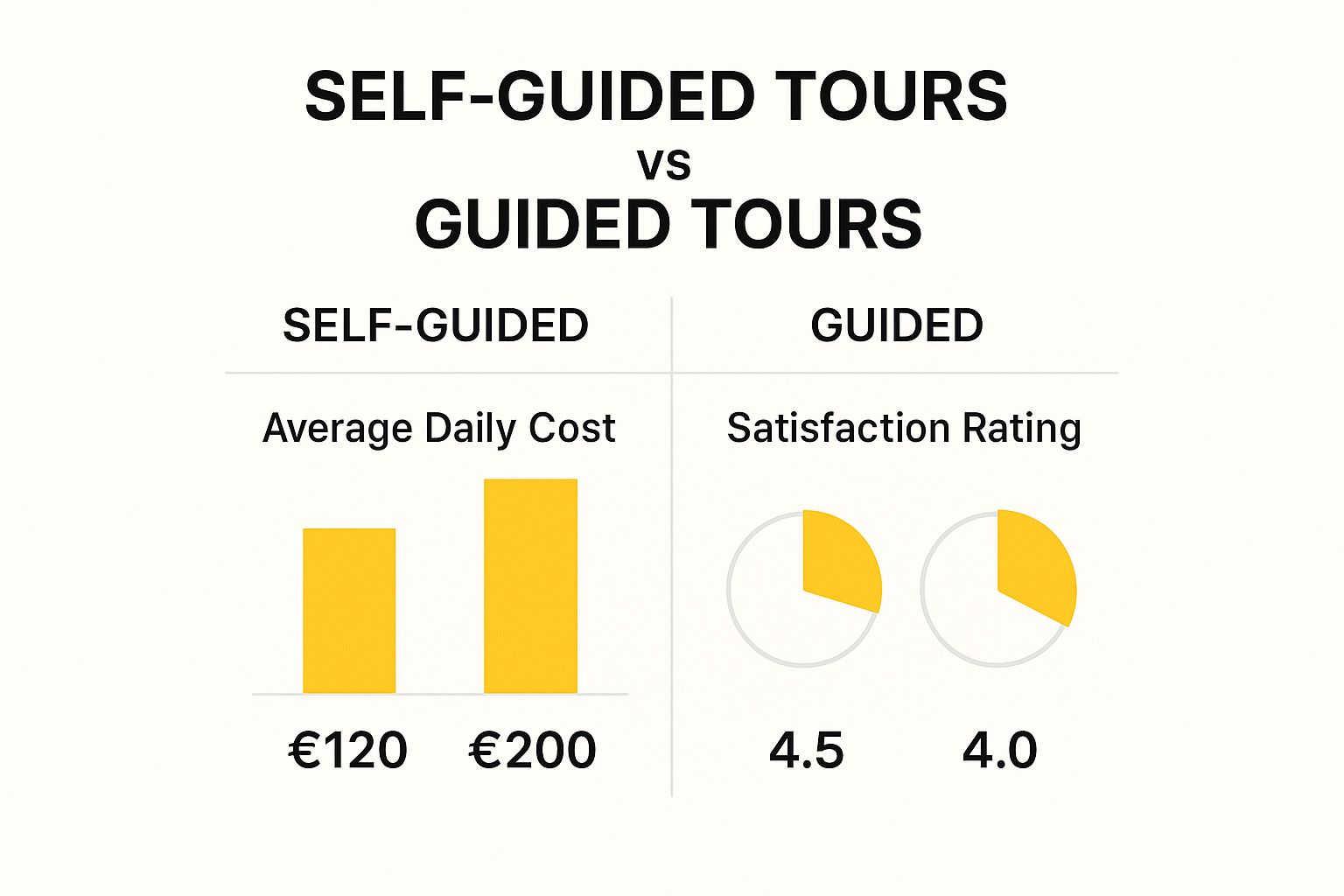
As you can see, the data suggests that travelers on self-guided tours often spend less per day while reporting higher overall satisfaction with their trip.
Self-Guided Freedom vs. Guided Tour Structure
Still weighing your options? This quick comparison should help you choose the travel style that best matches your ideal Irish adventure.
| Feature | Self-Guided Tour | Guided Coach Tour |
|---|---|---|
| Itinerary | Fully flexible; you decide the route and timing. | Fixed schedule with predetermined stops. |
| Pacing | Go at your own speed; linger where you love. | Moves with the group; strict timelines. |
| Experience | Discover hidden gems and local spots. | Focuses on major, well-known attractions. |
| Accommodation | Your choice of B&Bs, hotels, or rentals. | Pre-selected hotels, often larger chains. |
| Social | More intimate, ideal for couples or families. | Social environment with a large group. |
| Driving | You’re behind the wheel (on the left!). | Someone else handles the driving. |
Ultimately, if you value spontaneity and creating a truly personal journey, the freedom of a self-guided tour is hard to beat.
Overcoming Travel Hurdles
While this travel style offers incredible freedom, it’s also important to be aware of real-world factors like flight availability. For instance, early 2025 saw a temporary passenger cap at Dublin Airport, which limited inbound flights and drove up costs—a challenge for independent travelers who need that flexible air access.
Thankfully, with those kinds of restrictions lifted for peak seasons, flight capacity from markets like North America has bounced back, making it much easier to plan Ireland self-guided tours. You can find more details on these trends in this Tourism Ireland report. This is a good reminder of why it pays to book your flights well in advance to lock in the best routes and prices for your adventure.
Crafting Your Perfect Ireland Road Trip Itinerary
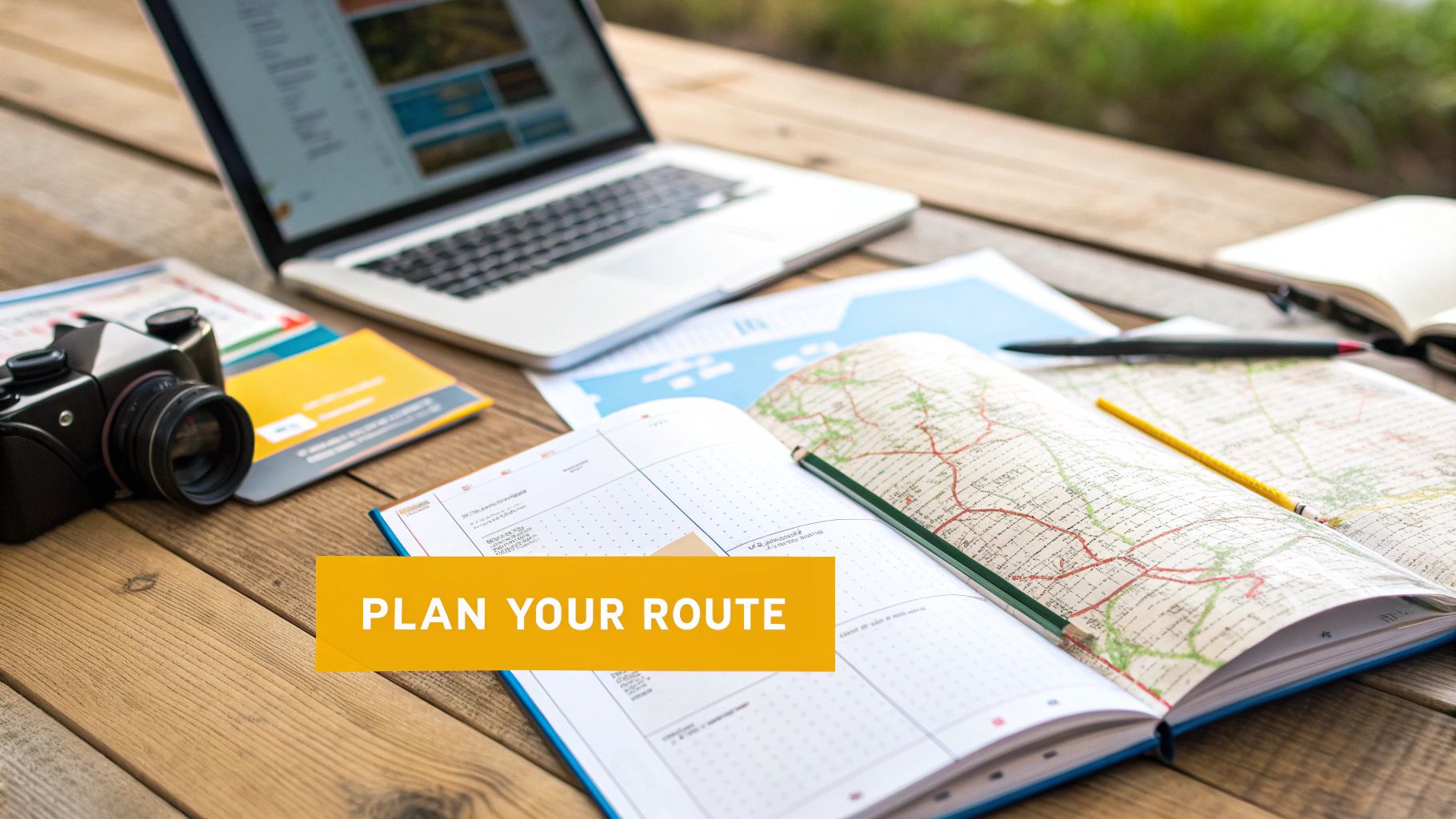
Alright, this is where the real fun begins—turning that dream trip into a workable plan. A great self-drive tour of Ireland is more than just a list of famous sights. It’s about crafting a journey that feels both exciting and realistic, respecting the landscape and your own pace. The secret is learning to balance the big-ticket destinations with those quiet, unexpected moments that truly define an Irish adventure.
One of the first lessons every road-tripper learns—sometimes the hard way—is to rethink driving times. A quick look at Google Maps might show Dublin to Galway as a two-hour zip across the country, but that’s on the motorway. That completely misses the point. The real magic happens on those skinny backroads and coastal lanes. Trust me, driving 100km on the Wild Atlantic Way is a whole different world than 100km on the M6.
Structuring Your Route Geographically
The smartest way to plan your route is to think in regional clusters. Grouping your destinations keeps you from wasting precious hours backtracking. It’s a frustrating mistake to make. Luckily, Ireland is almost perfectly designed for this, with a few major touring routes that create a natural framework.
Instead of trying to pinball all over the island, focus your time and energy on one or two key areas. You’ll spend less time staring through a windshield and more time actually experiencing the country.
Here are a few of the most popular frameworks for Ireland self guided tours:
- The Wild Atlantic Way: This is the big one—an epic 2,600km coastal route that hugs the entire west coast from Donegal down to Cork. You’d need weeks to do it all, so most people pick a section, like the jaw-dropping cliffs of Clare and Galway or the rugged peninsulas of Kerry.
- Ireland’s Ancient East: This route explores everything south of Dublin down to Waterford. It’s steeped in 5,000 years of history, from Neolithic tombs and medieval castles to grand estates like Powerscourt.
- A Southern Loop: This is the classic for a reason. You might start in Dublin, head south to kiss the Blarney Stone near Cork, explore Killarney National Park, stand in awe at the Cliffs of Moher, and soak up the atmosphere in Galway before circling back.
By picking a main region, your trip develops a natural, logical flow. For example, if you land in Dublin with your heart set on the west coast, you could drive to Galway and use it as a home base. From there, you can take day trips to Connemara and the Cliffs of Moher before heading south through the Burren into County Kerry and eventually looping back.
The Art of Pacing Your Trip
The urge to see everything is powerful, but a trip planned like a checklist is almost never a fun one. A good rule of thumb I always recommend is to keep your main driving stints to no more than three to four hours per day. This leaves plenty of room in your schedule for spontaneous stops, lazy lunches, and those “I wonder what’s down that road” moments.
Don’t fall into the trap of over-scheduling. The journey is the destination in Ireland. You have to build in buffer time to pull over for a photo, explore a castle ruin you spot from the road, or linger over a pint in a village pub you stumble upon.
For instance, the drive from Cork to Limerick is a straightforward 90 minutes. But if you decide to detour via the stunning Dingle Peninsula—and you absolutely should—you need to dedicate the entire day to it. The famous Slea Head Drive loop on the peninsula is only about 47km, but with all the stops for views, beaches, and ancient sites, it can easily take three hours or more.
Sample Itinerary Concepts
To give you a better idea of what this looks like in practice, let’s sketch out a few days. My best advice? Never plan more than two major attractions in a single day.
Example: A 7-Day Taste of the West
- Days 1-2: Arrive in Shannon or Galway. Settle in and explore Galway City, catching some live music. The next day, take a drive into the wild, boggy landscapes of the Connemara region.
- Days 3-4: Head south. Experience the immense scale of the Cliffs of Moher and then explore the otherworldly limestone terrain of the Burren. Find a cozy B&B for the night in a village like Doolin or Lahinch.
- Days 5-6: Continue to the incredible Dingle Peninsula. Give yourself the entire next day for the Slea Head Drive and exploring the charming town of Dingle itself.
- Day 7: Wind your way through Killarney National Park before heading to Kerry or Shannon airport for your flight home.
This kind of itinerary is paced for enjoyment, not exhaustion. It cuts down on long drives and lets you really sink into some of Ireland’s most spectacular places. The key is to prioritize what matters most to you and accept you can’t see it all in one go—which is just the perfect excuse to start planning your return trip.
Booking Your Car and Accommodations Like a Pro
Alright, you’ve sketched out your dream itinerary. Now comes the fun part: making it real by locking in your wheels and your resting places. Getting these two things right is the secret to a smooth, stress-free adventure.
The choices you make here will color your entire trip. The size of your rental car and the type of lodging you pick aren’t just logistics—they define your daily experience on your Ireland self-drive tour. It’s the difference between a car that can handle narrow country lanes with ease and finding a place to stay that becomes a cherished memory in itself.
Choosing Your Home Away from Home
Ireland has a fantastic spread of places to stay, each offering a completely different vibe. Deciding between a grand hotel and a cozy B&B isn’t just about your budget; it’s about the kind of trip you want to have.
Many people fantasize about staying in a castle hotel, and don’t get me wrong, it can be a truly magical night. But they’re often destinations in themselves and can be quite pricey.
For a more personal and often more affordable experience, you can’t beat the classic Irish Bed & Breakfast. Staying in a B&B connects you directly with a local host who can give you priceless tips—from the best pub for traditional music to a scenic backroad that you won’t find on any map.
A farm stay is another brilliant option, especially if you’re travelling with family or just want to fully soak in the countryside. Waking up to the sounds of rural Ireland right outside your window is an immersion you just can’t get in town.
My favorite approach? Mix it up. Splurge on a memorable castle hotel for a night or two, but balance your budget by staying in charming, family-run B&Bs the rest of the time. You get the best of both worlds.
Because Ireland self-drive tours are so popular, the best places get snapped up months ahead of time, especially during the peak season from June to August. To avoid that sinking feeling of seeing “No Vacancy,” I’d recommend booking all your lodging at least three to four months before you go.
Navigating the Car Rental Process
Renting a car in Ireland is pretty straightforward, but a few key decisions will make a world of difference once you’re on the road. Don’t just click on the cheapest or biggest car you see.
First and foremost: think small. That big, comfortable SUV might look appealing online, but it quickly becomes a liability on the winding, stone-wall-lined lanes in rural Ireland. A smaller, compact car is so much easier to handle, park, and squeeze through tight village streets. You will thank yourself every single time you meet a tractor on a single-lane road. Trust me on this.
Here are the absolute non-negotiables when you book your car:
- Book an Automatic Transmission: This is a big one. Unless you are an expert at driving a stick shift and completely comfortable doing it with your left hand while navigating on the “wrong” side of the road, get an automatic. It removes a huge layer of stress and lets you actually enjoy the scenery.
- Understand Your Insurance: You’ll see the term Collision Damage Waiver (CDW). This is crucial. While some credit cards claim to offer rental car coverage, many specifically exclude Ireland. For total peace of mind, it’s often wisest just to take the full insurance offered by the rental company. Make sure you read the policy so you know exactly what’s covered.
- Reserve in Advance: Just like good B&Bs, rental cars—especially automatics—are in high demand. Book your car as soon as you’ve booked your flights. You’ll get better availability and a much better price.
Securing Your Bookings in a Competitive Market
Even when visitor numbers fluctuate, tourism is the lifeblood of Ireland’s economy. Most people are there for a holiday, which means you’re competing for the very same rooms and cars.
To give you an idea, even during a relatively quiet month like March, visitors recently spent €326 million. A huge chunk of those visitors—43%—chose to stay in hotels. This just goes to show how critical it is to book early. For more details on this, you can check out these tourism trends and statistics in Ireland.
By planning ahead, you’re not just securing a car and a room. You’re guaranteeing a relaxed, fantastic start to your incredible self-drive tour.
Getting Behind the Wheel: Essential Tips for Driving in Ireland
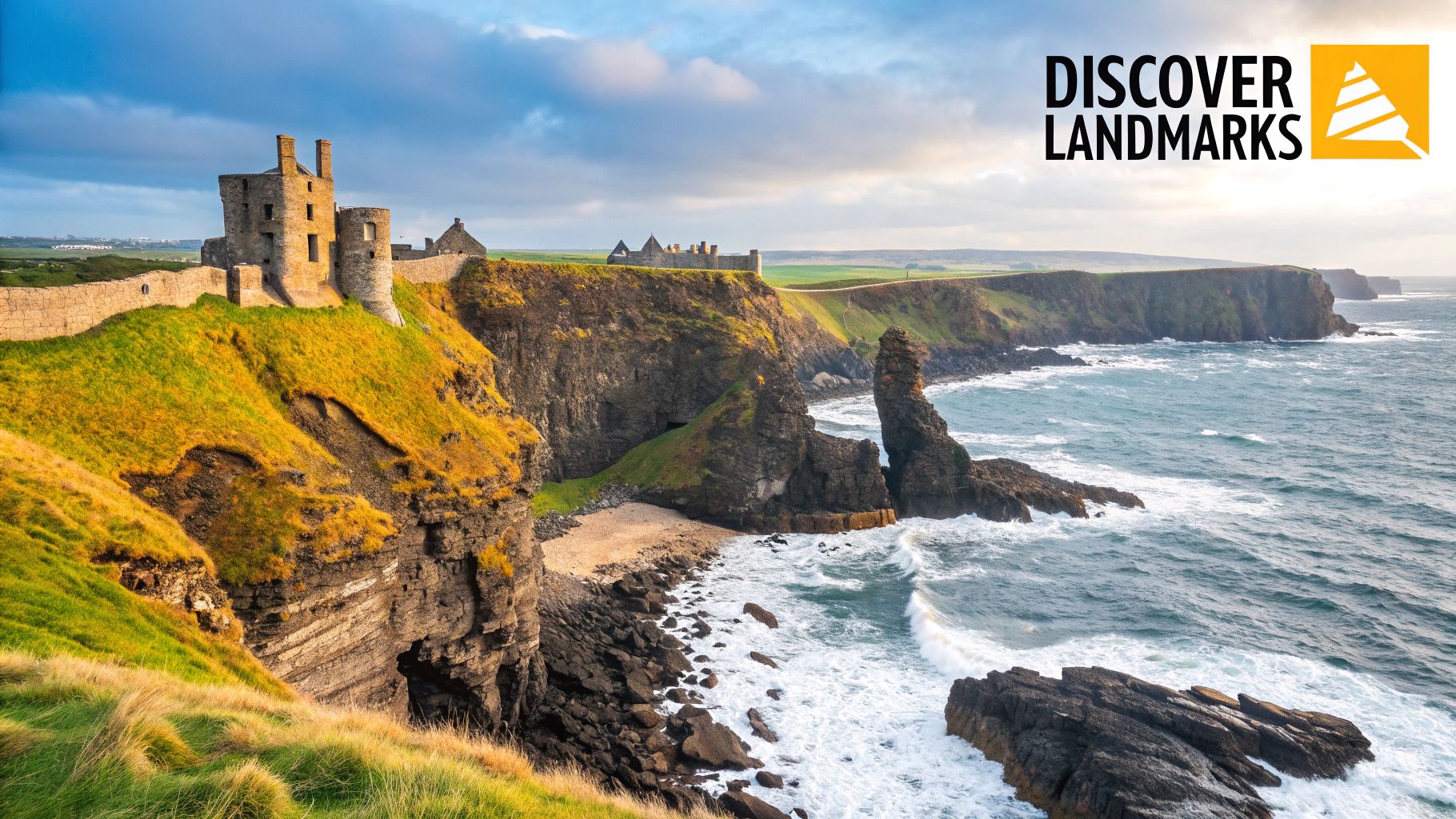
Let’s talk about driving in Ireland. For many people, two things immediately spring to mind: driving on the left and those famously narrow country roads. Yes, those are part of the deal, but getting behind the wheel is your golden ticket to seeing the real, unfiltered Ireland. This isn’t some daunting challenge; it’s the most freeing part of any Ireland self guided tour.
Driving is what lets you pull over for that jaw-dropping photo, stumble upon a hidden beach, or follow a curious sign to a castle ruin you just happened to spot. With a few pointers and the right attitude, you’ll quickly realize that driving here isn’t just doable—it’s an incredible amount of fun.
Mastering the Basics of Irish Roads
First things first: you’ll be driving on the left side of the road. This means your driver’s seat is on the right. It feels a bit odd for the first hour or so, but your brain clicks into gear faster than you’d expect. My go-to trick for the first day? I just keep repeating a little mantra, “stay left, stay left,” especially when pulling out of a junction or tackling a roundabout.
Speaking of roundabouts, they are everywhere in Ireland, from major motorways to tiny villages. The rule is simple: yield to traffic already in the circle, coming from your right. Once you’re on it, you have the right of way. Just remember to use your indicator to signal your exit, the same as you would for any other turn.
Another crucial detail is that speed limits are posted in kilometers per hour (km/h), not miles per hour (mph). Your rental car’s speedometer will likely show both, but all the road signs are metric. Pay close attention, as the limits can drop suddenly when you go from a rural road into a town.
Navigating Rural Roads and Local Etiquette
The real adventure starts when you get off the motorways. Ireland’s rural roads can be incredibly narrow, often hemmed in by ancient stone walls or thick hedgerows. These are the lanes that lead you to the heart of the country, and they just require a bit of patience and courtesy.
If you meet another car on a single-lane road, one of you will need to pull into a passing place or find a wide spot in the road. There’s a sort of unwritten rule of the road here: whoever has the easiest access to a pull-off spot is the one who yields. Don’t be shy about reversing a bit if you have to; it’s all part of the experience.
A quick, friendly wave of the hand is the universal “thank you” on these rural routes. It’s a small gesture that acknowledges the other driver’s courtesy and is a genuinely lovely part of the local driving culture.
You’ll also be sharing the road with tractors and, occasionally, a herd of sheep. When you come across them, just relax and be patient. Slow right down, give them plenty of room, and soak in the authentically Irish moment. It’s not a delay; it’s a photo op!
Road signs in Ireland can sometimes look a bit different from what you’re used to. Getting familiar with the most common ones before you hit the road can make you feel much more confident.
Decoding Common Irish Road Signs
| Sign Type or Symbol | What It Means in Ireland | How You Should React |
|---|---|---|
| Yellow Diamond with Black Arrow | Sharp Bend Ahead (direction of arrow shows the way) | Slow down significantly and prepare for a sharp turn. |
| Red Circle with a Number | Maximum Speed Limit (in km/h) | Do not exceed the speed shown. Fines can be steep. |
| White Circle with Black Diagonal Line | End of Speed Limit / National Speed Limit Applies | You can now drive at the national speed limit (100 km/h on national roads, 120 km/h on motorways). |
| Two Black Arrows Pointing in Opposite Directions | Two-Way Traffic Ahead | Be aware that oncoming traffic is now a factor. Common after a one-way street. |
| Yield Symbol (Upside-down Triangle) | Yield / Give Way | You must give way to traffic on the major road ahead. Prepare to stop. |
| Blue Circle with a White “M” | Motorway Begins | Motorway rules apply (e.g., no pedestrians, learner drivers, or slow vehicles). |
Understanding these basic signs will cover about 90% of what you’ll encounter, making your drive much smoother and safer.
Handling Tolls and Navigation
Most of Ireland’s major motorways have standard toll plazas where you can pay with cash or a credit card. Easy. But there’s one big exception to watch out for: the M50 motorway around Dublin. It uses a barrier-free toll system where cameras just snap a picture of your license plate. You’re responsible for paying that toll online or at a designated Payzone shop by 8 PM the next day. Definitely ask your rental company about how they handle M50 tolls when you pick up your car.
For getting around, I find a mix of modern tech and old-school maps works best. A GPS or an app like Google Maps is fantastic for turn-by-turn directions, but they can sometimes get confused on tiny back roads or lose signal in the more remote spots. That’s why having a good physical road map in the car is a lifesaver. It’s a great backup and also helps you see the bigger picture of your route, letting you spot interesting detours.
Parking in Towns and Cities
Parking can be a bit of a challenge in busy towns and cities. Your best bet is usually to look for designated car parks (parking lots). On-street parking often requires “pay and display”—you buy a ticket from a machine and put it on your dashboard. Always double-check the signs for time limits and restrictions to avoid a ticket.
And finally, the most important tip I can give you is to just relax and enjoy the drive. Your journey between destinations is a huge part of your adventure. Don’t try to rush it. Build extra time into your daily schedule, put on a great playlist, and truly embrace the freedom of the open road.
What to Pack for Ireland’s Famously Fickle Weather
You’ve probably heard the old saying: if you don’t like the weather in Ireland, just wait five minutes. It’s not an exaggeration. Packing for a place where you can experience sunshine, a light mist, gusty winds, and gray skies all in a single afternoon is an art form. The trick isn’t to bring your entire closet, but to pack clever, versatile pieces that play well together. This is doubly true for Ireland self guided tours, where you’re the one hauling your luggage.
The absolute foundation of any good Ireland packing list is layering. Don’t even think about a single bulky winter coat or a flimsy summer jacket. You need a flexible system. I always tell people to think in threes: a comfortable base layer (like a t-shirt), a cozy mid-layer for warmth (a fleece or wool sweater is perfect), and the most critical piece of all—your outer shell.
Your single most important purchase for this trip will be a genuinely waterproof and windproof jacket. And I mean waterproof, not “water-resistant.” A persistent Irish drizzle, what the locals call ‘soft weather,’ will laugh at a water-resistant jacket and leave you soaked and miserable. Look for something lightweight and breathable with a proper hood. This jacket will be your constant companion, from the blustery heights of the Cliffs of Moher to a sudden downpour while wandering through Dublin.
The Right Gear for Your Feet and Your Boot
What you put on your feet is nearly as important as your jacket. You’re going to be walking a lot, trust me. You’ll wander down cobblestone lanes in Galway, traipse across damp green fields to ancient monastic sites, and hike coastal paths. Comfortable, sturdy, and waterproof shoes are non-negotiable. A well-broken-in pair of walking shoes or low-cut hiking boots will serve you infinitely better than anything you chose for style.
When it comes to your luggage, think maneuverability. On a self-drive tour, you’re the bellhop. You’ll be loading bags into the car boot (trunk) daily and carrying them up the stairs of charming, traditional B&Bs that rarely have elevators.
- Soft-sided luggage or duffel bags are a lifesaver. They’re much easier to cram into a packed car than a rigid hardshell suitcase.
- A small daypack is essential. You can toss your camera, water bottle, wallet, and that crucial rain jacket in it for your daily excursions, leaving the big bag in the car or at your lodging.
Honestly, packing smart is about being ready for anything without being weighed down. A good waterproof jacket, a warm fleece, and one reliable pair of walking shoes will see you through 95% of whatever the Irish weather decides to do.
Don’t Forget the Essentials: Documents and Power
Beyond your wardrobe, a few practical items will make the entire trip seamless. It’s a good idea to keep all your important documents together in one easy-to-reach spot.
Your Go-Bag Checklist:
- Passport and valid driver’s license
- Car rental and accommodation confirmations (I keep digital copies on my phone and a printed set just in case)
- A credit card with no foreign transaction fees, plus some Euros in cash for small pubs or shops
- A UK/Ireland power adapter (Type G) for all your electronics
- A car charger or a portable power bank—your phone’s battery will drain quickly using GPS navigation
So, what can you leave at home? Heavy formal coats, multiple pairs of bulky shoes, and dressy outfits. Ireland is overwhelmingly casual and relaxed. Focus on comfort and practicality, and you’ll save yourself a lot of luggage-lugging grief, freeing you up to enjoy your adventure, come rain or shine.
Let Serendipity Be Your Co-Pilot
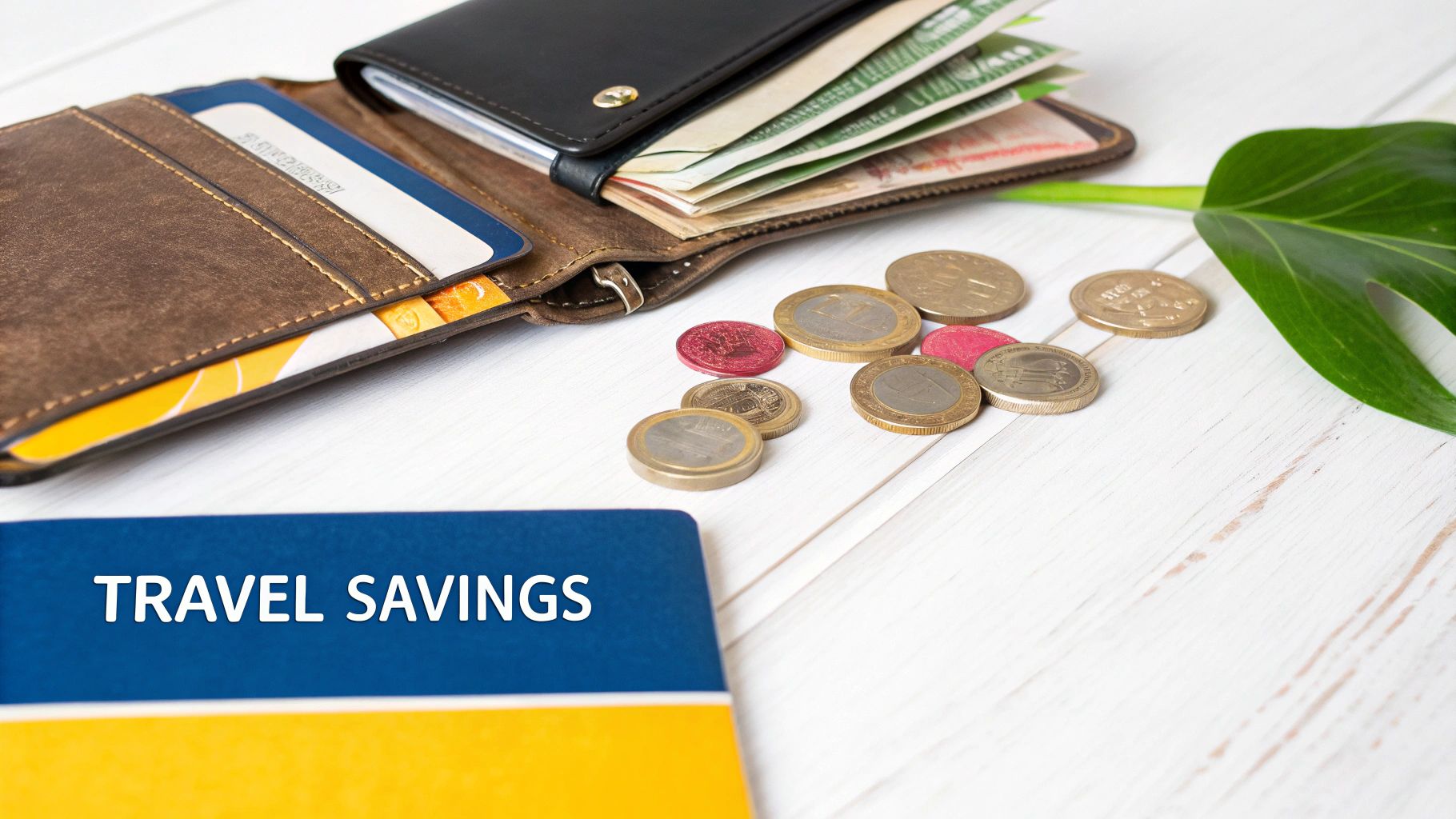
The very best Ireland self-guided tours are less about sticking to a rigid schedule and more about embracing a spirit of discovery. Think of your itinerary as a friendly suggestion, not a set of rules carved in stone. This is what allows you to craft a journey that feels uniquely yours.
The real magic of an Irish road trip unfolds in the unplanned moments. See a weathered wooden sign for a forgotten abbey? Take that turn. Spot a castle ruin on a distant hill? Go find it. I promise, your most treasured memories will come from these spontaneous detours.
Budget for Experiences, Not Just Expenses
When you’re on the road, try to build flexibility into your budget. This isn’t just about covering hotels and fuel; it’s about having the freedom to say “yes” to an unexpected opportunity. That might mean joining a last-minute trad session in a Doolin pub or hopping on a ferry to the Aran Islands because a local recommended it.
Managing your money is pretty straightforward. You’ll find that credit cards are widely accepted in most towns and cities. Still, I always recommend carrying a bit of cash. Having some Euros on hand is essential for small village shops, parking meters that only take coins, or leaving a tip for great service.
On that note, tipping culture in Ireland is more relaxed than in the States, but a thoughtful gesture for good service never goes amiss.
- Restaurants: If a service charge isn’t already added, 10-15% is a good rule of thumb.
- Pubs: No need to tip for drinks ordered at the bar. If you have table service, leaving a couple of Euros or rounding up the bill is a nice touch.
- Taxis: Simply rounding up to the nearest Euro is standard practice.
The real joy of a self-drive tour is the freedom it gives you. It’s the confidence to follow a winding road just to see where it goes, knowing that the detours often lead to the best discoveries.
Even when global travel hits a few bumps, tourism remains a vital part of the Irish economy. By taking a self-guided tour, you’re directly supporting the small businesses that are the heart of the country. Every stay in a local B&B or scone from a family-run café helps sustain Ireland’s largest indigenous employer. For a deeper look into this, check out the tourism sector insights from the Irish Examiner.
So go on, embrace the freedom of the open road. Strike up conversations with the people you meet. Let Ireland reveal its secrets to you, one beautiful, winding lane at a time.
Got Questions About Driving Yourself Around Ireland?
Let’s face it, planning a trip like this brings up a lot of questions. Getting them sorted out beforehand is the key to a stress-free adventure. I’ve heard them all over the years, so let’s tackle the big ones.
The most common question I get is, “How many days do I really need?” You could blitz the highlights in five days, but you’d be exhausted. To truly soak it all in, aim for at least a week to ten days.
With seven days, for example, you can do a fantastic loop through the south—hitting places like Cork, Killarney, and the Cliffs of Moher—without feeling like you live in your rental car. It gives you time to actually get out, hike a bit, and find a proper pub.
Your Budget and When to Go
People often worry if a self-drive tour in Ireland will break the bank. It really doesn’t have to. Your two biggest expenses are always going to be the car rental and where you sleep. Booking these a few months ahead, especially if you choose charming local B&Bs over big hotels, makes a huge difference.
For daily spending money, a good ballpark figure is €70-€100 per person. This should comfortably cover your food, fuel, and entry fees for most attractions.
As for the best time to visit, you’re looking for that sweet spot. May, June, and September are my personal favorites. You get lovely weather (by Irish standards!) and the summer crowds haven’t fully descended yet. July and August are gorgeous but be prepared for busier roads and higher prices.
A quick but important tip: Your home country’s driver’s license will almost always be accepted, but it’s smart to get an International Driving Permit (IDP). It’s cheap, easy to get, and serves as an official translation of your license, which can save a lot of hassle.
And what about staying connected for maps and looking things up on the fly? You can’t always rely on spotty public WiFi, especially out in the countryside. I always suggest looking into the best portable WiFi for travel before you go. Having your own hotspot means your GPS will work anywhere, and you can book that last-minute castle tour without a problem.
Ready to stop dreaming and start driving? At BTOURS, we specialize in crafting unforgettable self-drive tours across Ireland. We handle the details so you can focus on the adventure. Explore our curated Ireland itineraries and book your trip today!

